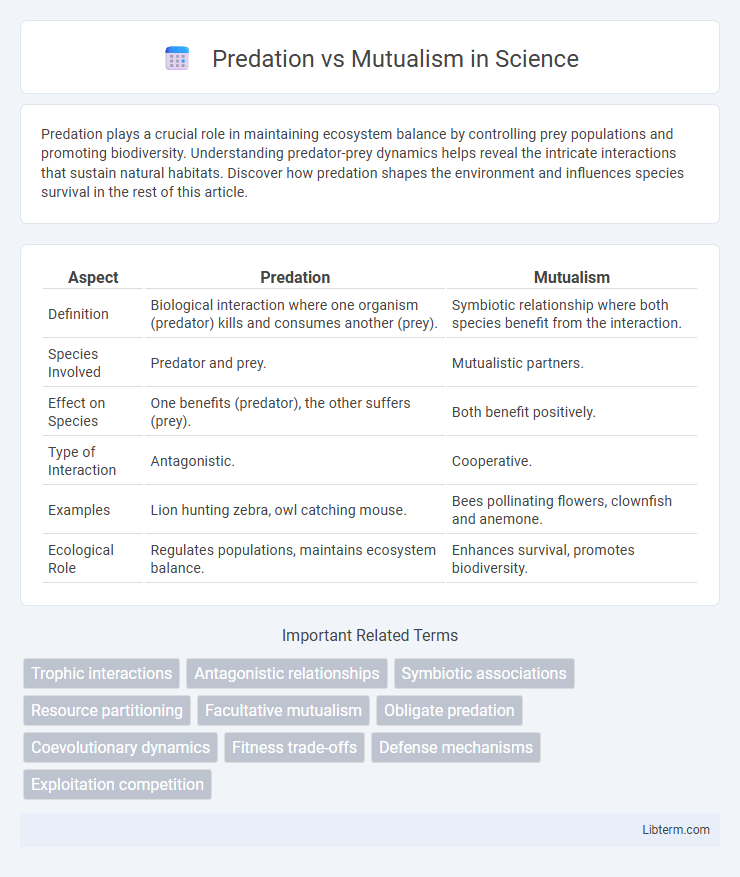Predation plays a crucial role in maintaining ecosystem balance by controlling prey populations and promoting biodiversity. Understanding predator-prey dynamics helps reveal the intricate interactions that sustain natural habitats. Discover how predation shapes the environment and influences species survival in the rest of this article.
Table of Comparison
| Aspect | Predation | Mutualism |
|---|---|---|
| Definition | Biological interaction where one organism (predator) kills and consumes another (prey). | Symbiotic relationship where both species benefit from the interaction. |
| Species Involved | Predator and prey. | Mutualistic partners. |
| Effect on Species | One benefits (predator), the other suffers (prey). | Both benefit positively. |
| Type of Interaction | Antagonistic. | Cooperative. |
| Examples | Lion hunting zebra, owl catching mouse. | Bees pollinating flowers, clownfish and anemone. |
| Ecological Role | Regulates populations, maintains ecosystem balance. | Enhances survival, promotes biodiversity. |
Introduction to Species Interactions
Predation involves one species, the predator, feeding on another, the prey, which affects population dynamics and ecosystem balance. Mutualism, by contrast, benefits both interacting species, enhancing survival, reproduction, and resource acquisition. These species interactions shape biodiversity, ecological networks, and evolutionary processes within habitats.
Defining Predation
Predation is an ecological interaction where one organism, the predator, hunts, kills, and consumes another organism, the prey, to obtain energy and nutrients. This relationship significantly influences population dynamics and community structure by regulating prey populations and promoting natural selection. Predation differs from mutualism, which involves a reciprocal benefit between two species rather than a consumptive interaction.
Understanding Mutualism
Mutualism is a type of symbiotic relationship where both species involved derive benefits, enhancing their survival and reproductive success. This interaction can involve resource exchange, protection, or enhanced habitat for one or both partners, exemplified by pollinators and flowering plants or nitrogen-fixing bacteria and legumes. Understanding mutualism highlights the cooperative dynamics in ecosystems that contribute to biodiversity and ecological balance.
Key Differences Between Predation and Mutualism
Predation involves one organism, the predator, feeding on another organism, the prey, resulting in harm or death to the prey, while mutualism is a symbiotic relationship where both species benefit from the interaction. In predation, the relationship is antagonistic, characterized by a clear winner and loser, whereas mutualism promotes cooperative interactions that enhance survival and reproduction for both parties. Predator-prey dynamics influence population control and natural selection, whereas mutualistic relationships contribute to ecosystem stability and resource sharing.
Ecological Impacts of Predation
Predation regulates population dynamics by controlling prey abundance and preventing species overpopulation, which maintains ecosystem balance and promotes biodiversity. Predatory interactions drive natural selection, encouraging prey species to develop adaptive traits such as camouflage, speed, or defensive mechanisms. Furthermore, predation influences energy flow and nutrient cycling within food webs, shaping community structure and ecosystem function.
Benefits and Examples of Mutualism
Mutualism benefits both species by providing resources, protection, or enhanced survival capabilities, such as bees pollinating flowers while collecting nectar. Predation benefits one organism through feeding but harms the other, as seen with a lion hunting a zebra. Examples of mutualism include clownfish living among sea anemones for protection while cleaning parasites from the anemones.
Evolutionary Adaptations in Predators and Mutualists
Predators have evolved specialized adaptations such as sharp teeth, enhanced sensory organs, and camouflage to efficiently locate and capture prey, driving natural selection for survival skills. Mutualists develop complementary traits, like specialized pollinator beaks and flower shapes or nutrient-exchanging structures in lichens, which reinforce interspecies cooperation and increase reproductive success. These evolutionary adaptations highlight divergent strategies; predators optimize hunting efficiency while mutualists enhance reciprocal benefits, shaping ecological relationships and biodiversity.
Case Studies: Predation in Nature
Predation in nature exemplifies complex ecological interactions, as seen in the classic case of the Canadian lynx and snowshoe hare, where population cycles of predator and prey demonstrate dynamic balance in forest ecosystems. Another notable example is the African lion's role in regulating herbivore populations on the savannas, which maintains biodiversity and ecosystem stability. These case studies highlight predation's critical function in shaping community structures and energy flow within habitats.
Case Studies: Mutualistic Relationships
Case studies of mutualistic relationships highlight beneficial interactions between species that enhance survival and reproduction, such as the symbiosis between clownfish and sea anemones, where clownfish gain protection while anemones receive cleaning services. Another prominent example is the pollination mutualism between bees and flowering plants, where bees obtain nectar and pollen as food sources while enabling plant reproduction through effective pollen transfer. These mutualistic relationships demonstrate coevolution and ecological balance, emphasizing the importance of cooperation over predation in certain ecosystems.
Balance of Predation and Mutualism in Ecosystems
The balance of predation and mutualism in ecosystems regulates population dynamics and enhances biodiversity. Predation controls species abundance, preventing overpopulation, while mutualism fosters cooperative interactions that improve resource availability and ecosystem resilience. Maintaining this equilibrium is essential for ecosystem stability and the sustainable functioning of natural habitats.
Predation Infographic

 libterm.com
libterm.com